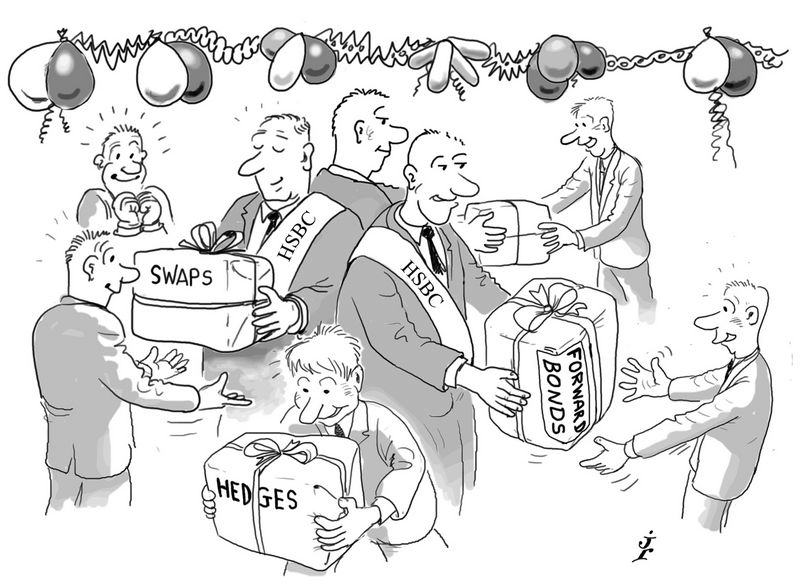Steady hand: The first rates bear market for many years came as the sector was facing a barrage of new regulations, and made an already challenging backdrop even worse. For weathering the storm, and remaining committed to servicing its clients’ risk management needs, HSBC is IFR’s Interest Rate Derivatives House of the Year.
Rates markets suffered through a brutal 2013. Speculation that the US Federal Reserve would reduce its bond purchases unleashed the first bear market since quantitative easing began. But investors were caught on the back foot in September when the tapering did not materialise.
After that, dysfunction in Washington over the debt ceiling brought the markets to a standstill – and the third-quarter results of banks unambiguously showed the extent of the damage. At some houses, fixed-income revenues fell by almost 50%.
These challenges came just as a tidal wave of regulation was hitting the interest rate derivatives business. Capital rules began to bite; clearing and exchange-trading began to take off in the US; and the industry was blindsided by the prospect of the leverage ratio squeezing banks’ balance sheets (based on a completely different range of metrics than what had been expected).
As many of its traditional rivals in fixedincome struggled to cope with the regulatory onslaught, however, HSBC stepped up its game.
On the back of a strong Core Tier 1 capital ratio of 13.3%, a healthy leverage ratio of 4.2% and robust credit ratings, the bank helped its diverse client-base navigate this uncertain environment and unfailingly met its funding and risk management needs.
“Our business is completely organised around the client, with a focus on simplicity, transparency and consistency of pricing,” said Thibaut de Roux, HSBC’s head of markets for EMEA.
Well-balanced client list
“Our client-base is well balanced between corporates and institutions, between developed markets and emerging markets. And year to date, their activity is aligned with last year – a claim that not many banks can make.”
The bank’s results back that up. Revenues across global markets remained steady versus 2012 – at around US$7.5bn for the first nine months of the year – while the 18% dip in rates from US$2.2bn to US$1.8bn amounted to a far sturdier effort than most of the bank’s peers.
HSBC’s renowned presence in EM meant it was on call during the violent sell-off after the Fed tapering talk set in. The bank helped clients hedge sharp moves in EM currencies and interest rates. It was also at the forefront of the fledgling renminbi market as the currency this year made it into the list of top 10 globally traded currencies, according to the Bank for International Settlements. This further opened up both investment and hedging opportunities.
Meanwhile, in developed markets there was a relentless focus on the regulatory constraints facing both banks and their clients. HSBC helped firms find financing for less liquid assets, either to source collateral for central clearing or for their own funding needs.
“Banks that can’t provide good funding solutions will struggle,” said Elie El Hayek, global head of rates. “Our clients are changing and so is our business, as the regulatory framework around the globe becomes more complex. It is not only about derivatives, but what is the right solution for the client and for us – whether that is bonds or derivatives.”
HSBC also looked to innovate as capital constraints made parts of the business trickier. Encouraging clients to buy FX options on the back-end exchange of principals in cross-currency swaps allowed the bank to be at the forefront of this credit-intensive business, which remains vital for corporates seeking to tap foreign currency markets.
And long hours spent analysing northern European pension fund portfolios allowed HSBC to design hedging strategies to cope with changes in liability management processes.
The bank also showed its prowess in the inflation space as sole duration manager on the UK DMO’s 2068 index-linked Gilt, which extended the UK inflation curve by six years and represented the largest duration event ever in the Gilt market. It backed this up with sizeable inflation trades for corporate and institutional clients, recycling billions of pounds of risk with ease.
On the asset side of the balance sheet, HSBC pioneered forward bonds as a way for asset managers to pick up yield – which proved invaluable for clients hitting return targets.
“Derivatives and other asset classes are becoming more interlinked,” said El Hayek. “We are not grabbing market share for market share’s sake. It is about having a deep, strategic dialogue with the client and deciding whether derivatives are the right option versus something else.”
To see the full digital edition of the IFR Review of the Year, please click here.
To purchase printed copies or a PDF of this report, please email gloria.balbastro@thomsonreuters.com

